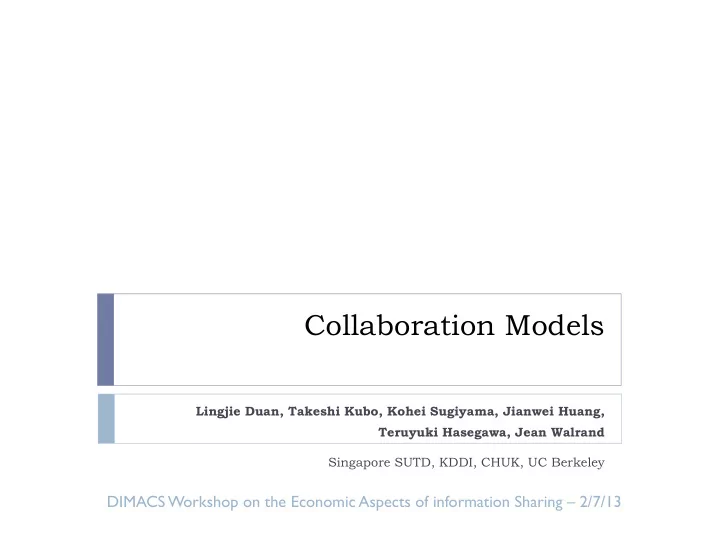

Collaboration Models Lingjie Duan, Takeshi Kubo, Kohei Sugiyama, Jianwei Huang, Teruyuki Hasegawa, Jean Walrand Singapore SUTD, KDDI, CHUK, UC Berkeley DIMACS Workshop on the Economic Aspects of information Sharing – 2/7/13
Overview Data collection & cooperation on tasks Incentives for collaboration? We model cooperation in two situations: Model 1: “Data Collection Game” : share reward if successful Model 2: “Task collaboration”: contract 2
Model 1 Value V Client If n ≥ n 0 collaborations C j C 1 C N Collaboration costs: iid, F(.) known N known 3
Model 1 Value V Client If n ≥ n 0 collaborations Collaboration costs C j C 1 C N Scheme: Client proposes a reward R R is divided among collaborators, if n ≥ n 0 Questions: Whether to collaborate? How to choose R? 4
Scheme: Client proposes a reward R Model 1 R is divided among collaborators Value V Client If n ≥ n 0 collaborations Collaboration costs C j C 1 C N Nash equilibrium: Collaborate if C i ≤ γ γ = unique solution of = 0 where m = B ( N, F ( γ )) 5
Scheme: Client proposes a reward R Model 1 R is divided among collaborators N = 100 n 0 = 40 C i = U[0, 4] E.g., R = 100 →γ = 2 note that E[n] = 50 6
Scheme: Client proposes a reward R Model 1 R is divided among collaborators Choosing R: where n = B ( N, F ( γ ∗ ( R ))) 7
Scheme: Client proposes a reward R Model 1 R is divided among collaborators Choosing R: V = 100 n 0 = 30 C i = U[0, 3] 8
Model 2 Client K j K 1 K N Collaboration costs, per unit of effort Type i: Reward r Effort t Client’s utility: 9
Model 2 Client Proposes contract K j K 1 K N Selects j : I will produce t m units of effort for reward r m 10
Model 2 Client N users, each user has type i w.p. q i Algorithm for optimal design of contract 11
Model 2 N = 120 3 types q i = 1/3 θ i = 5 12
Summary Design of collaborations 1) “Data Collection” Share R if n ≥ n 0 V for client Collaborate if cost ≤ γ * Calculate optimal R 2) “Collaboration on task” User of type i w.p. q i Design of optimal contract 13
This presentation is based on the following paper: Lingjie Duan, Takeshi Kubo, Kohei Sugiyama, Jianwei Huang, Teruyuki Hasegawa, Jean Walrand, “Incentive Mechanisms for Smartphone Collaboration in Data Acquisition and Distributed Computing,” INFOCOM 201 2. 14
Recommend
More recommend